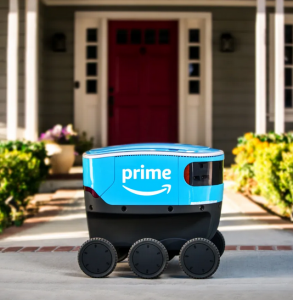Amazon is up to something in autonomous vehicles (AV) – is it really looking to deliver by drone, especially for groceries? That’s part of the story.
Amazon has been very active in AV’s over the past few years:
- In June 2020, Amazon bought Zoox for $1.2 billion, an AV startup that just announced a functional AV robo-taxi (stage 5).
- Amazon has invested in Aurora (July 2019), another AV startup that recently bought Uber’s ATG technology and team in a stock deal, for a total of about 40% of Aurora
- It’s also been working for more than a year with robo-trucking startup Embark, testing its use in Amazon’s long-haul network
- Amazon has for a while been working on rolling drones for local delivery. In 2020, it added two new test sites, Atlanta GA and Franklin TN, for its (July 2020). The Scout tests are integrated with Amazon’s standard delivery system, so customers in test locations may have their packages delivered by rolling drone. That’s part of an AV team Amazon formed in 2017 (around the time it partnered with Uber and Toyota on another AV concept project, e-Palette).

- Amazon Prime Air – Amazon’s aerial drone project – recently receive approval from the US Federal Aviation Authority (FAA) to start testing aerial drones, which have been in development for years – Amazon previously released a video showing an AV flying drone in December 2016, and claims to have Prime Air development centers in the United States, the United Kingdom, Austria, France and Israel (August 2020).
- Amazon is planning a new rural delivery service (November 2020). This makes no sense as a business – taking on expensive rural deliveries is the last thing on Amazon’s bucket list – but it does make sense for testing drone deliveries, as FAA approval allows drone use beyond line-of sight only where the drone doesn’t fly over people or inhabited buildings i.e. in rural areas
Clearly, Amazon can see – just like Uber has – that functioning AV delivery (for packages instead of people) can cut Amazon’s general cost of business substantially. That’s important, as Amazon’s shipping and fulfillment costs have ballooned to 29% of gross revenue in retail (as of 2019 – it’s likely increased post-pandemic and post-1-day shipping). Drone delivery is also more scalable more quickly than human delivery. Delivery even just for small items could cut delivery costs significantly.
However, there are limitations. Rolling drones have to deal with a host of obstacles, and not just knocked over scooters littering the sidewalks. Delivery often requires opening gates, managing stairs, and leaving packages in odd places. Rolling drones cannot do any of that, so they are best seen as supplementary tools to cut costs in parts of the network where they make sense.
But AV’s don’t just save Amazon money. They provide a significant cost and reliability advantage against competitors who are in any event struggling to stand up a full delivery competitor against Amazon. They can in particular transform the economics of grocery delivery, which is increasingly important to Amazon as it goes all-in on a sector where to has no other significant competitive advantages and plenty of headwinds.
Walmart, Target, and other retailers currently rely on curbside pickup to compete. The Walmart+ platform cannot match Amazon Prime delivery, and Shopify doesn’t have independent delivery capacity at all, even if it does offer merchants other advantages across the ecommerce value chain. No retailers seem prepared to commit the resources to match Amazon’s logistics network.
Amazon is taking Av serious partly to cut costs, which matters now that Amazon is losing money on retail, and partly for insurance. AV is a potential threat to Amazon’s current competitive advantages. Amazon wants to make sure that it can at least match AV technologies from elsewhere, in case Walmart takes a leaf out of Amazon’s book and buys the leading AV company, which Amazon did In warehouse robotics when it bought Kiva in 2012.
AV can help Amazon within its current business model, and path-breaking AV technology could be a game changer for its big retail competitors. By investing heavily, Amazon guarantees access to cutting edge AV delivery technology. It would be a bonus if Zoox, Aurora, the Scout, aerial drones, or some other Amazon AV tech happened to deliver critical breakthroughs that finally let Amazon roll out AV in its last mile network .
Either way, Amazon is covered.
